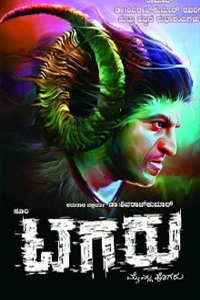The doyen of Kannada cinema Dr Girish Kasaravalli draws away from the normal screenplay narration of his previous films. He applied the split narration technique and leaves the audience to decide on three layer cinema.
Perhaps this kind of narration would keep the audience glued to their seats. What is told in the commercial cinema the expert in direction Dr Girish Kasaravalli narrates in a cool as cucumber style and the pattern is new to him. The alternative he has worked for the characters shows his thinking pattern nowadays.
What is interesting in the out set is the characters the director introduces and the strength it possess. Even when he introduces a small role of Kumari Soundarya the grand daughter role he looks at the perspective of the world.
For the lazybones who dreams of earning in life at the behest of God the director charges very well. With the character of Irya and his wife he looks at maximum of people living in society on such concepts. Dr Girish Kasaravalli does not stop at this. He goes to another extreme step of village Gowda family. When the father is dead the son finishing his task for the future ignoring what he is supposed to do holds a mirror to the majority in society.
The four times Swarana Kamal winner at the national level Dr Girish Kasaravalli's latest film `Kanasemba Kudhureyaneri' is second in a row with producer Basanthkumar Patil after `Gulabi Talkies'.
The film is all about a grave digger in the village Iriya. He can foresee events before it happens. When he sees Siddha, his master and messenger of death, in his dream, he believes that the ailing septuagenarian Gowda of the Big House is dead and so prepares a grave for the dead man. He is confused and struck with self-doubt when the caretaker of the Big House denies any death in the house. He can't believe his dream could go wrong.
The film retells the story of the Senior Gowda's death from the viewpoints of the caretaker. The Gowda is, of course, dead, but the caretaker has his own reasons to hide it. The villagers ignorantly believe the caretaker more than the poor grave digger.
Next day, Rudri, the wife of Irya, in her dream sees Siddha visiting the village. The whole village is excited to welcome Siddha as he is believed to bring good luck. Even this dream fails to become true. Irya and his wife are devastated and wonder how all of a sudden their dreams started failing. Without dreams their life become even more unbearable.
The ending of the film offers three different perspectives. What if Irya is killed? Would Irya, with his beliefs, with his way of life, survive? Would a frustrated Irya give up digging graves and take to another profession? Three different narratives explore the different possibilities.
Every character has the life and purpose in this film. When a flower trader gives Rs.50 instead of Rs.100 there is some element stored in the character.
Biradar from the regular commercial films beggar roles lends some relief. The hunger in him to give good performance is seen. Umasri is once again best. Sadashiva Brahmavar has remained absolutely perfect to the role. There is admirable support from artists like Shivaranjan, Pavitra Lokesh as couple. Soundarya the playing kid in this film represents the future of society is remarkable.
The cinematography by Ramachandra heightens the value of the film. The coverage of extensive lands the beautiful `Vaade' (ancient house) come out well in the camera work.
V Manohar gives music according to the mood. This is worth watching film for many reasons.
Score - 7.5/10










Comments